Sausage, Cabbage, and Apple Skillet
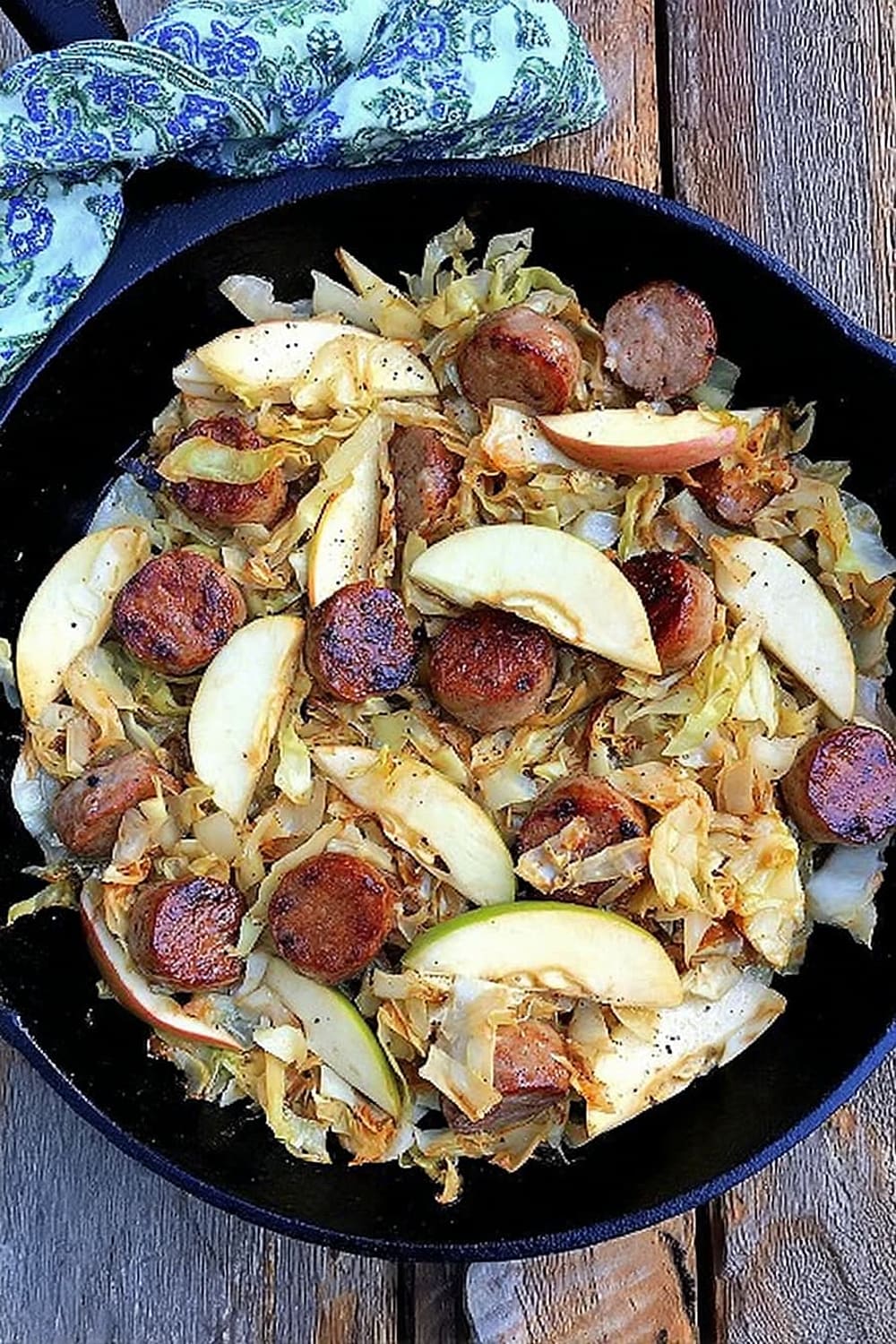
This one-pan wonder is basically autumn’s love letter to your dinner table, complete with sweet apples, savory sausage, and tender cabbage all mingling together like old friends at a harvest party.
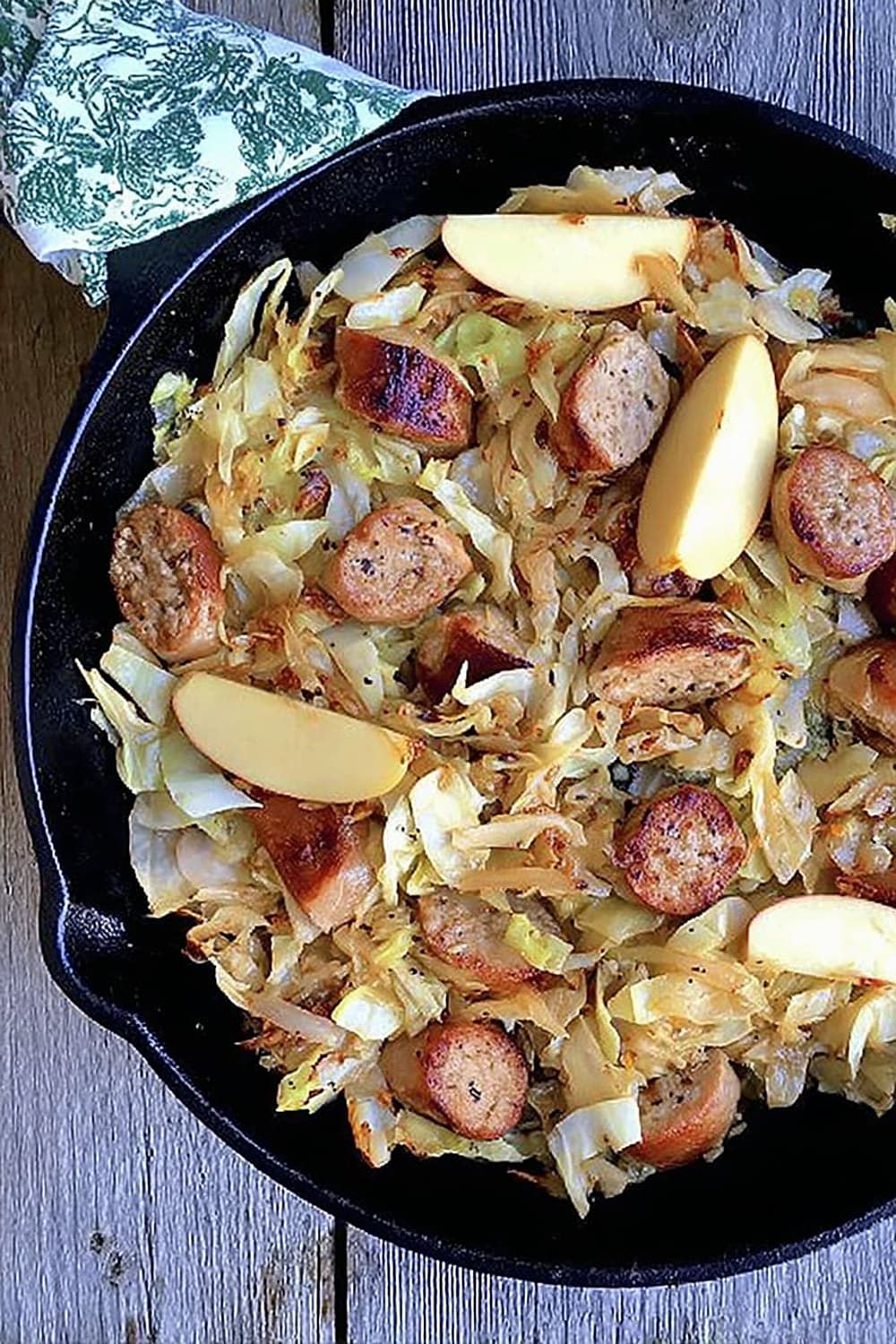
The magic happens when those pre-cooked chicken apple sausages start browning in your cast iron skillet, releasing their smoky-sweet aroma that’ll have your neighbors wondering what culinary masterpiece you’re creating over there.
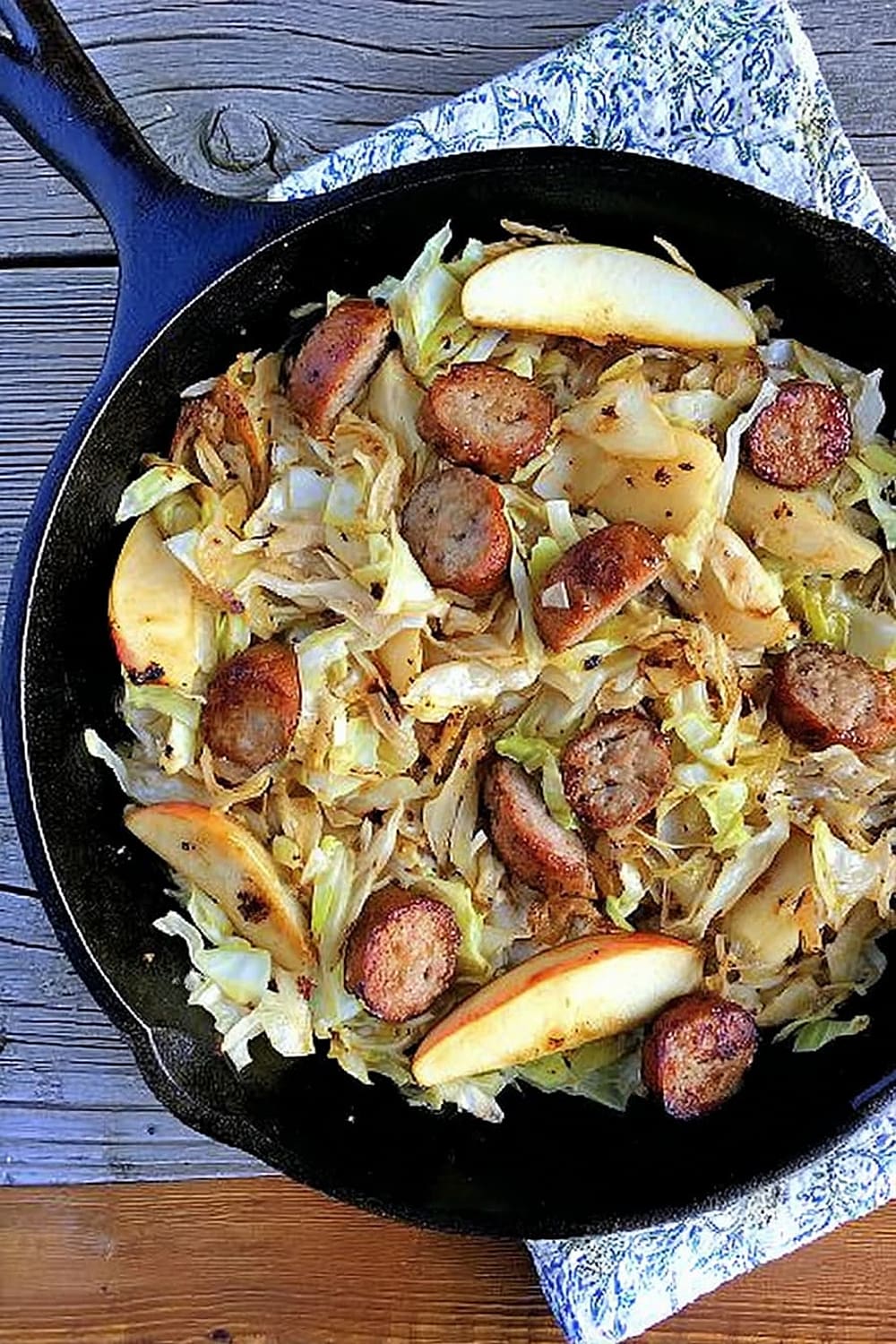
What makes this recipe absolutely brilliant is how the cabbage transforms from humble vegetable to silky, caramelized perfection while soaking up all those incredible flavors from the sausage and apple cider vinegar.
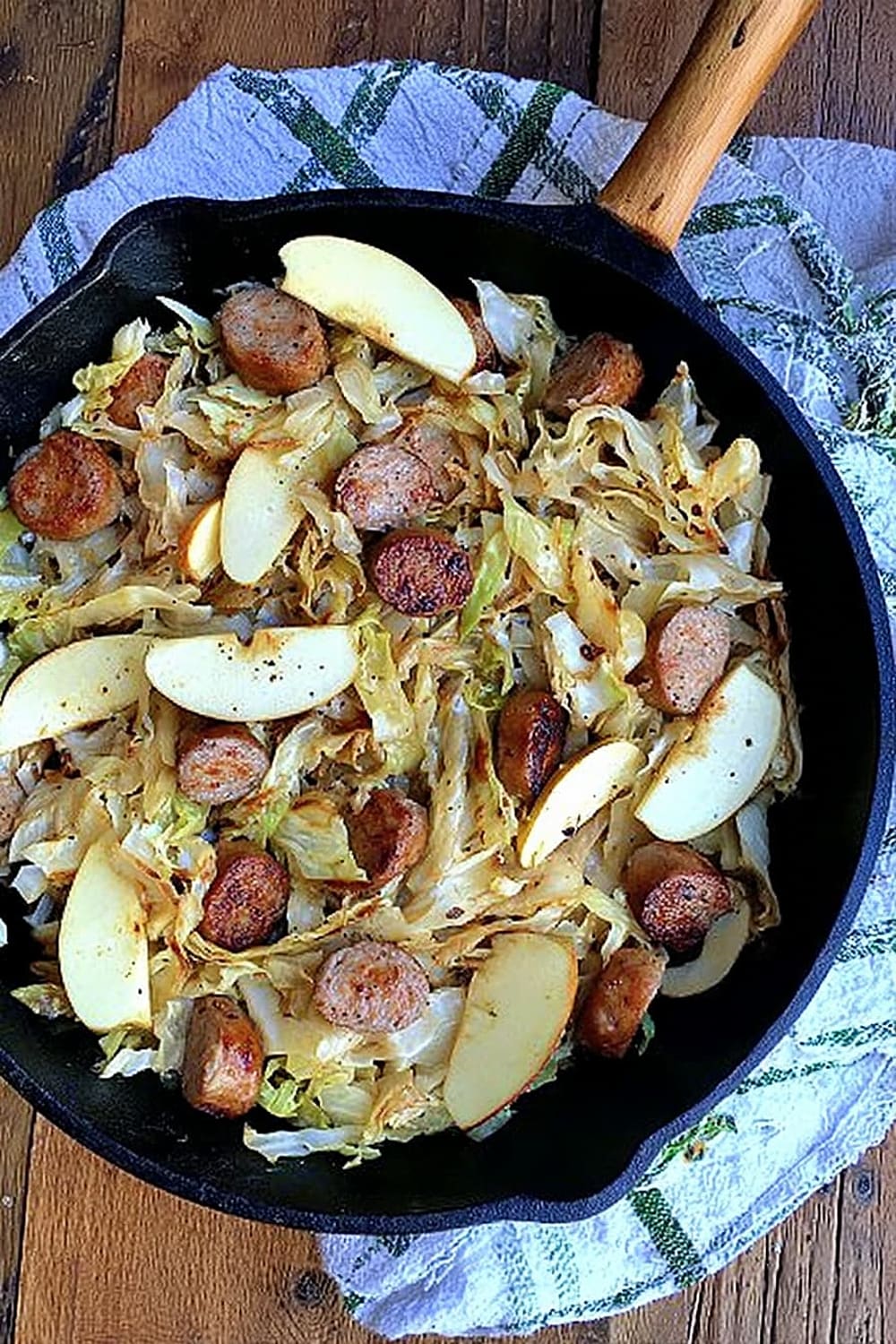
Those crisp Granny Smith apples add the perfect sweet-tart contrast, holding their shape just enough to give you delightful little bursts of freshness in every bite without turning to mush.

This is comfort food that doesn’t require you to hover over the stove for hours – everything comes together in about 20 minutes, making it perfect for those weeknight dinners when you want something impressive but don’t have the energy for complicated cooking.
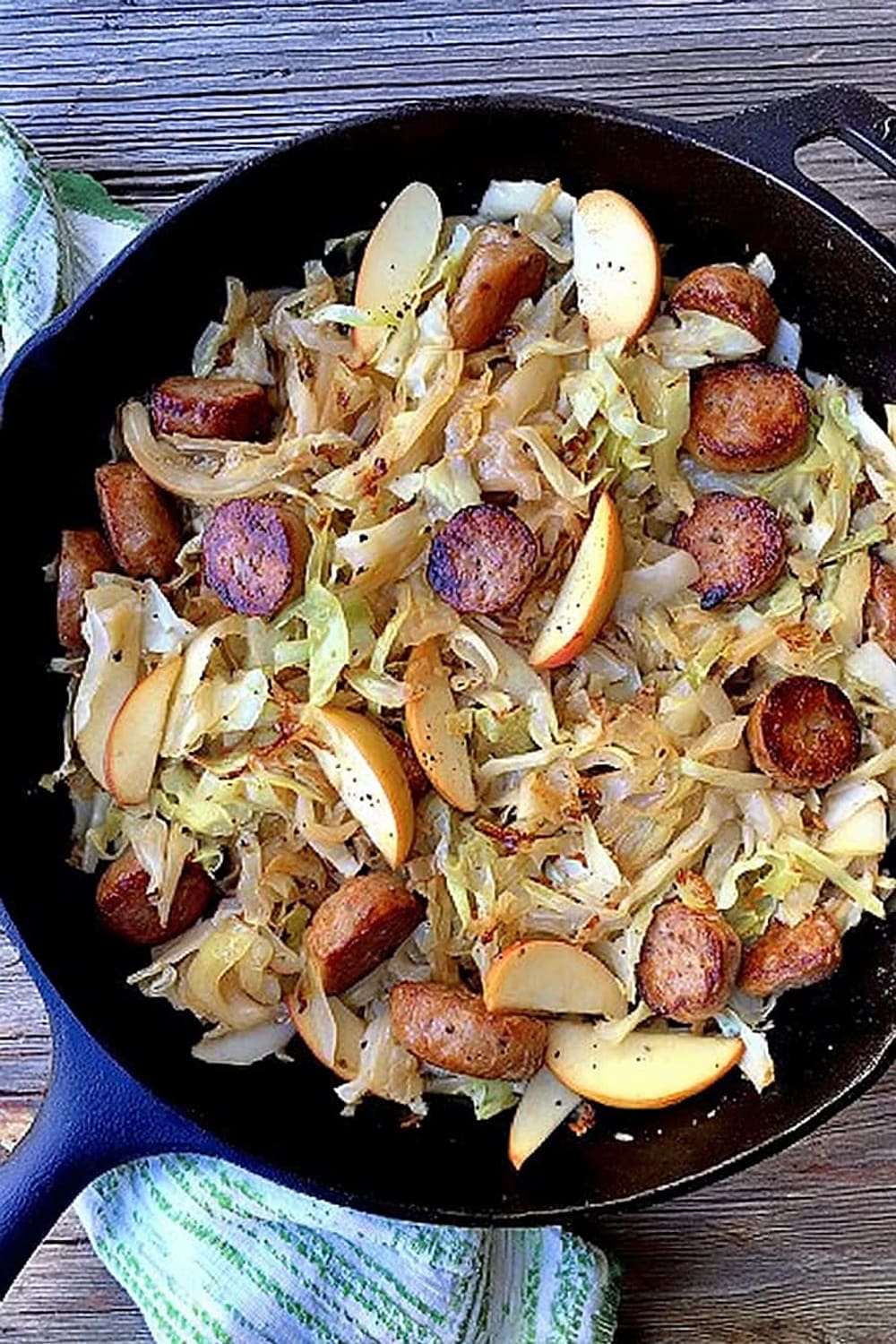
The best part is watching everyone’s face light up when they realize this simple combination of ingredients creates something that tastes like you’ve been slow-cooking it all day long.
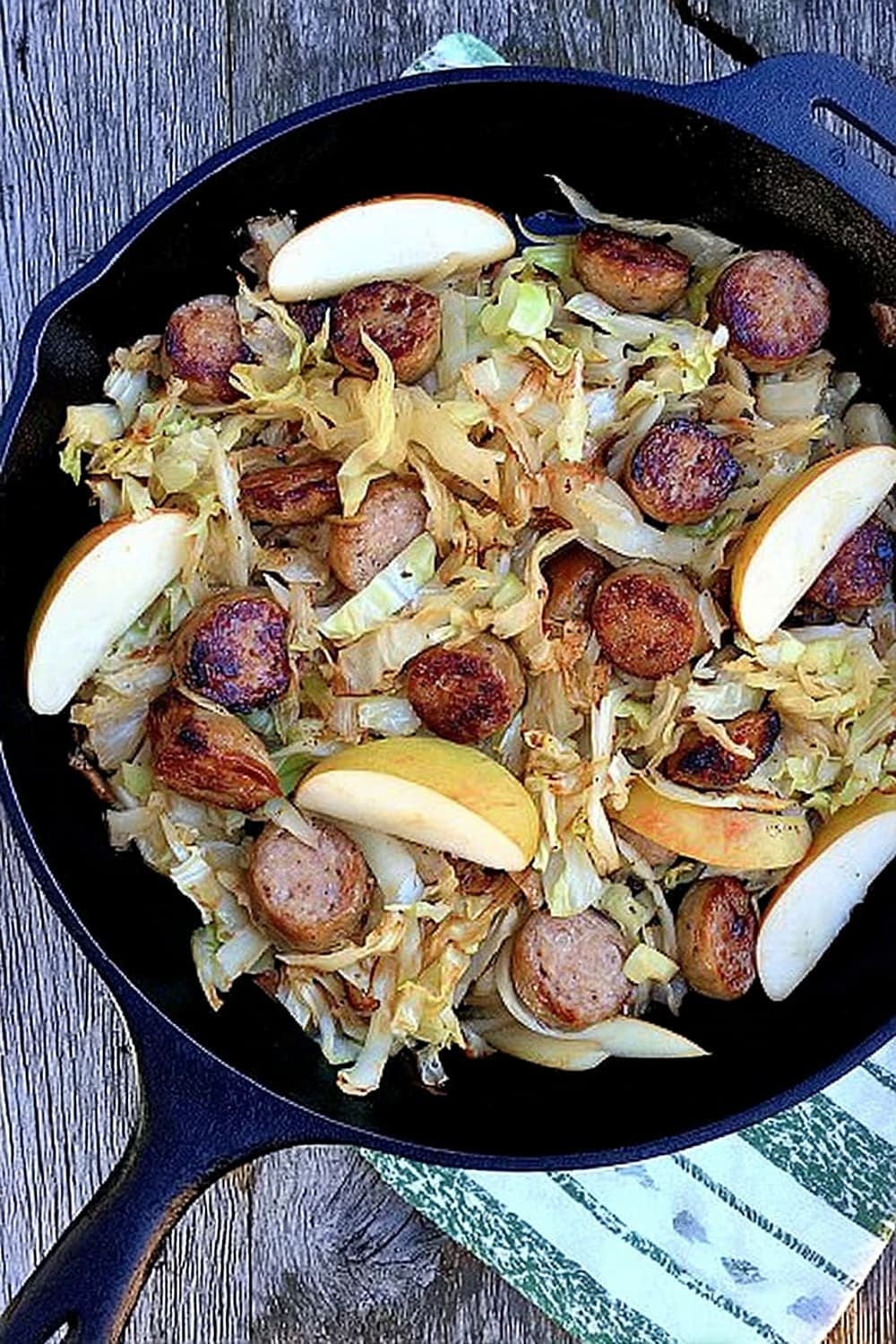
Ingredients
For the Main Skillet
- 4 pre-cooked chicken apple sausages (about 12 ounces), cut crosswise into thirds
- 2 teaspoons extra-virgin olive oil
- 1 medium red or yellow onion, thinly sliced
- 1 small head red or green cabbage
- 2 medium tart apples, such as Granny Smith or Pink Lady
- 2 tablespoons apple cider vinegar
For Seasoning and Serving
- Salt and fresh black pepper to taste
- Favorite mustard to serve on the side
- Good, crusty bread for serving
Instructions
Prepare the Sausage Base
- 1 Set your biggest skillet (preferably a cast iron skillet for even heat distribution) over medium-high heat. Add the sausages and cook until they begin to develop a golden-brown crust, about 3-4 minutes. This initial browning creates a flavorful fond that will enhance the entire dish.
- 2 Drop the heat to medium and add the extra-virgin olive oil followed by the sliced onion. Sauté the onion and sausages together for 3-5 minutes until the onion becomes tender and translucent. The oil will help deglaze any browned bits from the sausage, creating a rich base layer of flavor.
Add the Vegetables
- 3 While the onion cooks, prepare your cabbage using a sharp knife and cutting board. Cut the cabbage in half through the core, then trim out the tough core and discard it. Shred the cabbage into thin strips, similar to how you would prepare it for coleslaw. Add the shredded cabbage to the skillet and cook, stirring regularly with tongs or a wooden spoon.
- 4 The cabbage will initially seem like a lot of volume, but it will quickly wilt down as it cooks. Continue stirring regularly to ensure even cooking and prevent any pieces from burning. The cabbage should start to soften and become more vibrant in color after about 2-3 minutes.
Finish with Apples and Seasoning
- 5 While the cabbage cooks, prepare your apples on a clean cutting board. Cut the apples off the cores in four clean cuts, then slice them into ¼-inch thick slices. When the cabbage is nearly tender (about 5 minutes total cooking time), add the apple slices to the skillet.
- 6 Sauté the apple slices for 2-3 more minutes until they’re tender but still hold their shape – you want them soft enough to bite through easily but not mushy. Remove the skillet from heat and stir in the apple cider vinegar, which will brighten all the flavors and add a pleasant tang. Season generously with salt and freshly ground black pepper to taste.
Serve
- 7 Transfer to serving plates and serve immediately with good, crusty bread and your favorite mustard on the side. The contrast of textures and the warmth of the dish make it perfect for cool weather dining.
Recommended Equipment and Kitchen Tools
Essential Tools (for best results)
- Cast iron skillet or heavy-bottomed pan – The even heat distribution helps caramelize the vegetables perfectly while preventing hot spots that could burn delicate apple pieces
- Sharp chef’s knife – Makes quick work of slicing onions uniformly and cutting cabbage into consistent shreds for even cooking
- Wooden cutting board – Provides a stable surface for prep work and won’t dull your knife blade like glass or stone surfaces
- Tongs or wooden spoon – Essential for stirring the large volume of cabbage without scratching your pan’s surface
Helpful Upgrades
- Mandoline slicer – Creates perfectly uniform onion and apple slices for professional-looking results and even cooking
- Kitchen scale – Ensures accurate portioning of sausages and helps with consistent results every time you make this recipe
- Instant-read thermometer – While not essential for this recipe, it’s handy for checking that pre-cooked sausages reach 165°F (74°C) if you’re concerned about food safety
Nice-to-Have Options
- Silicone spatula – Great for scraping up any caramelized bits from the bottom of the pan
- Large mixing bowls – Useful for holding prepped vegetables if you like to have everything ready before you start cooking
Recipe Variations and Dietary Modifications
Protein Variations
- Turkey sausage – Swap chicken apple sausages for turkey versions for a leaner option with similar flavor
- Plant-based sausage – Use your favorite vegan sausage for a completely plant-based meal
- Fresh sausage – Replace pre-cooked sausages with fresh bratwurst or Italian sausage, but cook thoroughly first
Vegetable Modifications
- Brussels sprouts – Replace half the cabbage with halved Brussels sprouts for added texture and nutrition
- Sweet potatoes – Add diced sweet potatoes with the onions for extra heartiness and natural sweetness
- Bell peppers – Include sliced red or yellow bell peppers for additional color and crunch
Flavor Enhancements
- German-inspired – Add caraway seeds and use bratwurst with sauerkraut instead of fresh cabbage
- Harvest spice blend – Include a pinch of cinnamon, nutmeg, and thyme for warming fall flavors
- Wine deglaze – Replace apple cider vinegar with white wine for a more sophisticated flavor profile
Seasonal Adaptations
- Winter version – Add diced butternut squash and dried cranberries
- Spring variation – Include fresh herbs like parsley and chives, plus early spring onions
- Summer twist – Use zucchini and yellow squash instead of cabbage
Nutritional Information and Health Benefits
Key Nutritional Highlights
This hearty skillet provides approximately 304 calories per serving with a balanced macronutrient profile. Each serving delivers high-quality protein from the chicken sausages, beneficial fiber from the cabbage and apples, and heart-healthy monounsaturated fats from the extra-virgin olive oil. The dish is naturally low in refined carbohydrates while providing complex carbs from the vegetables and fruit.
Health Benefits of Main Ingredients
The cabbage in this recipe is a nutritional powerhouse, packed with vitamin C, vitamin K, and folate. It also contains powerful antioxidants called anthocyanins (especially in red cabbage) and glucosinolates, which have anti-inflammatory properties. Apples contribute pectin, a soluble fiber that supports digestive health and helps regulate blood sugar levels. They’re also rich in quercetin, an antioxidant that supports heart health. The extra-virgin olive oil provides beneficial monounsaturated fats and vitamin E, while the apple cider vinegar may help with blood sugar regulation and provides probiotics if unfiltered.
Dietary Considerations
This recipe is naturally gluten-free (check sausage labels to confirm), dairy-free, and fits well into paleo and Whole30 eating patterns. It’s also suitable for low-carb diets, with approximately 15-18 grams of carbohydrates per serving, mostly from the vegetables and fruit. The high fiber content (about 4-5 grams per serving) helps slow digestion and promotes satiety.
Smart Swaps and Ingredient Substitutions
Sausage Substitutions:
- Chicken apple sausages → Polish kielbasa or andouille sausage (slice similarly)
- Pre-cooked sausages → Fresh bratwurst or Italian sausage (cook thoroughly first)
- Chicken sausages → Turkey or pork sausages with apple or herb flavoring
Vegetable Swaps:
- Red cabbage → Green cabbage, Napa cabbage, or Brussels sprouts
- Yellow onion → Sweet onion, shallots, or leeks (white and light green parts)
- Granny Smith apples → Honeycrisp, Braeburn, or firm pears
Acid Alternatives:
- Apple cider vinegar → White wine vinegar, rice vinegar, or dry white wine
- Vinegar → Fresh lemon juice (use slightly less)
Budget-Friendly Swaps:
- Chicken apple sausages → Regular chicken sausages plus a diced apple
- Extra-virgin olive oil → Regular olive oil or avocado oil
- Specialty mustard → Yellow mustard or Dijon mustard
Pro Tips for Substitutions:
- When using fresh sausages instead of pre-cooked, add 5-7 minutes to cooking time
- If substituting sweeter apples, reduce cooking time by 1 minute to prevent mushiness
- Store leftover apple cider vinegar in a cool, dark place for up to 2 years
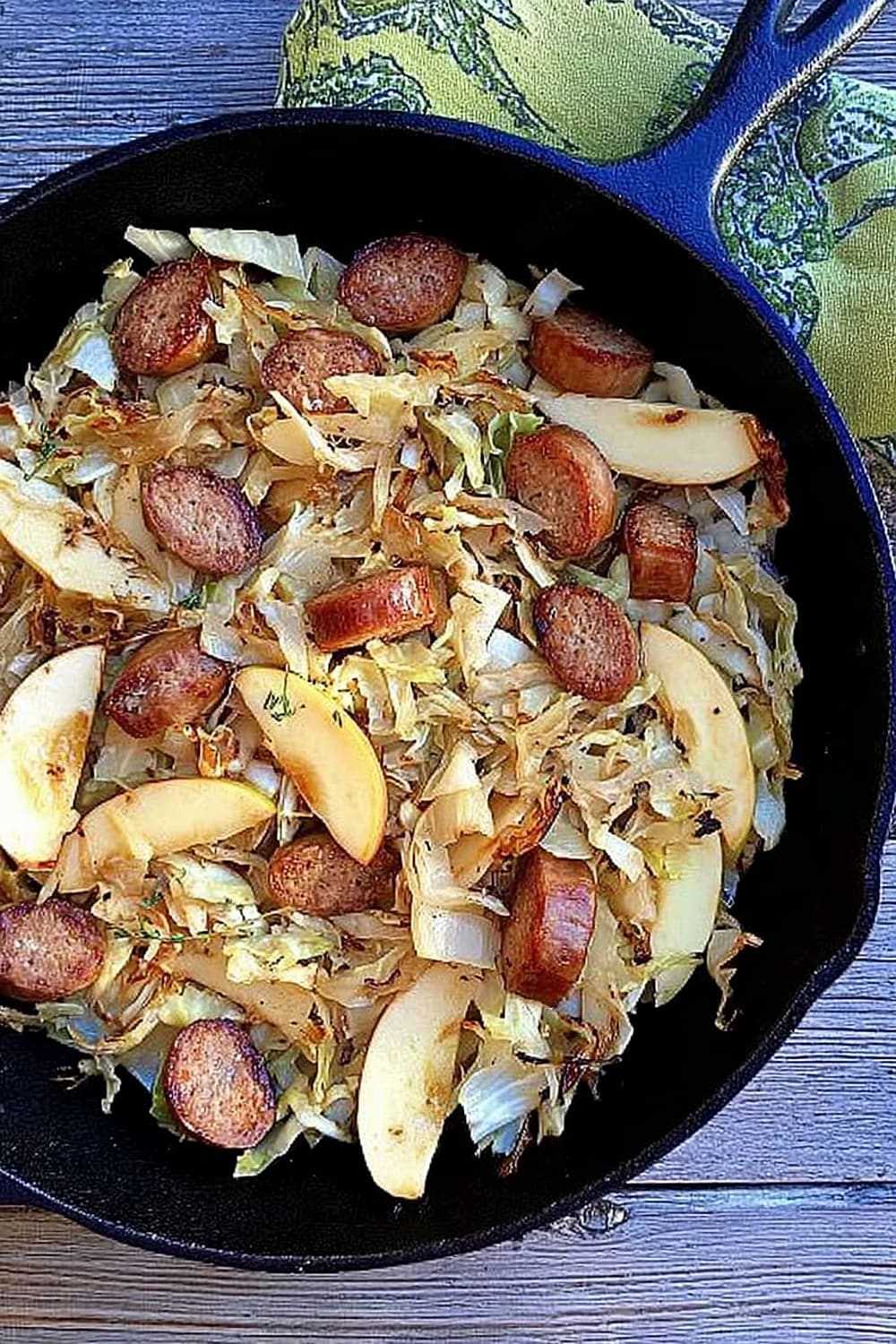
Make It Diabetes-Friendly
Carbohydrate Modifications:
- Reduce apple quantity from 2 medium apples to 1 large apple to decrease natural sugars by approximately 8-10 grams of carbs per serving
- Increase cabbage portion to maintain volume and add more fiber, which helps slow glucose absorption
- Choose tart apple varieties like Granny Smith over sweeter options to minimize sugar content
Portion & Timing Tips:
- Recommended serving size: Keep portions to about 1 cup per serving for approximately 12-15 grams of carbohydrates
- Pair with protein: Add a side of grilled chicken breast or serve over cauliflower rice to increase protein and fiber
- Meal timing: This lower-carb version works well for lunch or dinner when paired with a small salad
Cooking Method Adjustments:
- Extra fiber boost: Add 1 tablespoon of ground flaxseed during the last minute of cooking for additional fiber without extra carbs
- Healthy fats: Increase olive oil slightly to 1 tablespoon to help slow carbohydrate absorption
- Vinegar benefit: The apple cider vinegar naturally helps moderate blood sugar response
Total Carb Reduction: These modifications reduce the dish from approximately 18 grams to 12-15 grams of carbohydrates per serving while maintaining full flavor and satisfaction.
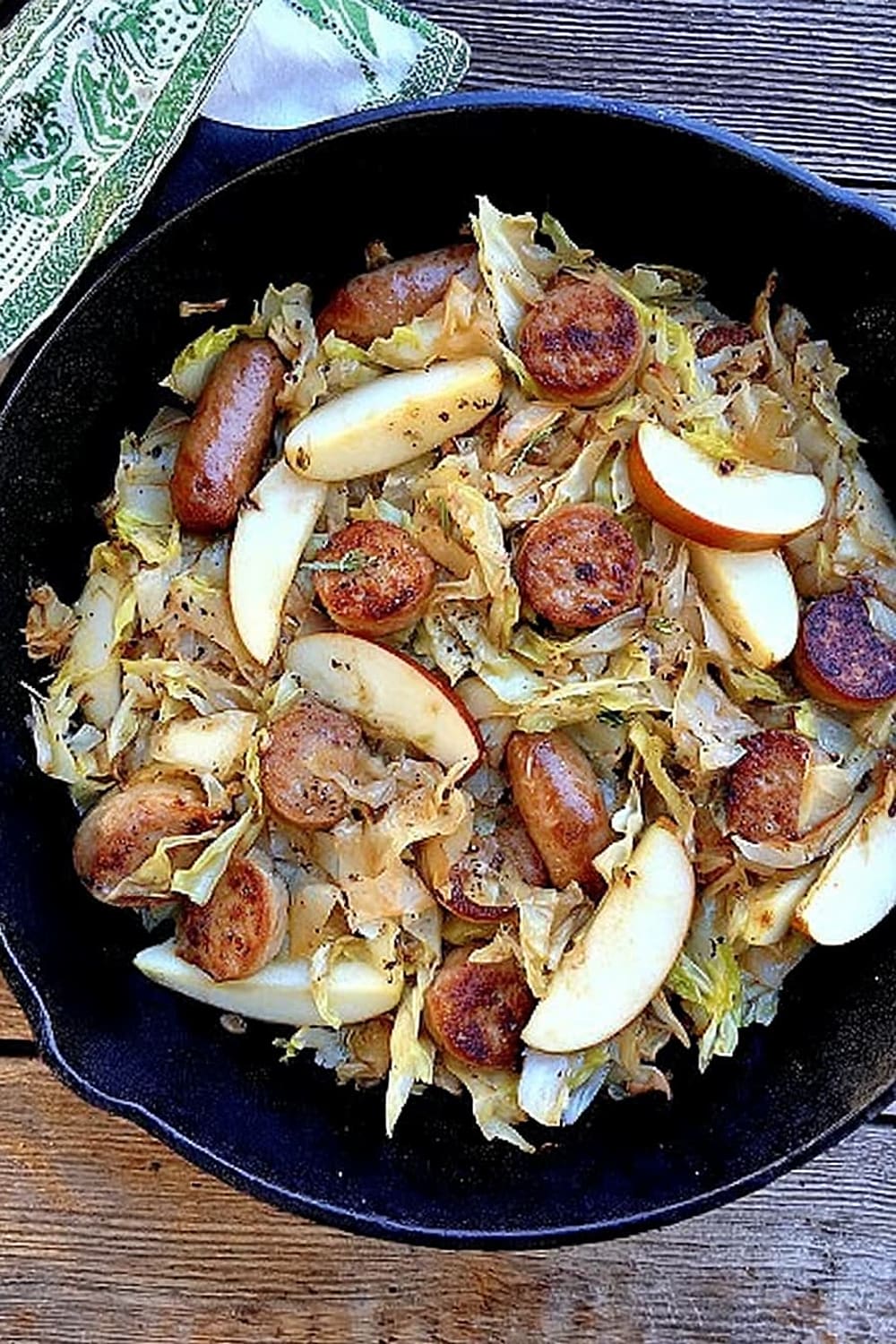
Perfect Pairing Suggestions
Beverage Pairings
A crisp Riesling or Gewürztraminer complements the sweet-savory balance beautifully, while the wine’s acidity echoes the apple cider vinegar. For beer lovers, a German Oktoberfest or Belgian wheat beer provides the perfect malty backdrop to the sausage and apple flavors. Sparkling apple cider offers a non-alcoholic option that enhances the apple notes, while unsweetened iced tea with lemon provides a refreshing contrast to the rich, warm dish.
Side Dish Recommendations
Crusty sourdough bread or pretzel rolls are classic accompaniments that help soak up the flavorful pan juices. A simple arugula salad with lemon vinaigrette adds peppery freshness and cuts through the richness. Roasted root vegetables like carrots and parsnips extend the autumn theme, while German-style spaetzle or egg noodles transform this into a more substantial meal. Pickled vegetables or sauerkraut provide tangy contrast that complements the dish’s German-inspired flavors.
Complete Meal Ideas
Start with a warm butternut squash soup to embrace the seasonal theme, then serve the skillet as your main course with honey wheat dinner rolls. For dessert, apple crisp or pear tart continues the orchard fruit theme. This combination works perfectly for Oktoberfest celebrations, harvest dinners, or cozy Sunday suppers when you want comfort food that feels both rustic and refined.
Pro Tips and Troubleshooting
Professional Techniques
Don’t overcrowd your skillet – if doubling the recipe, use two pans or cook in batches to ensure proper browning and prevent steaming. The key to perfect texture is cooking the cabbage until it’s tender but still has slight bite – overcooking turns it mushy and bitter. Taste and adjust seasoning at the end, as pre-cooked sausages vary in saltiness between brands.
Common Mistake Prevention
Never add the apple cider vinegar while the pan is still over high heat, as it can become harsh and overpowering. Instead, remove from heat first, then stir in the vinegar to preserve its bright, tangy flavor. Cut apple slices uniformly so they cook evenly – pieces that are too thick won’t soften properly, while pieces that are too thin will turn to mush.
Storage and Make-Ahead
This dish keeps well in the refrigerator for up to 3 days and actually improves in flavor as the ingredients meld together. Reheat gently in a skillet over medium-low heat, adding a splash of apple cider or broth if needed. For meal prep, prepare all vegetables in advance but cook the dish fresh for best texture. Freezing isn’t recommended as the apples and cabbage lose their pleasant texture when thawed.
Recipe Scaling
This recipe doubles easily – just use a larger skillet or cook in two batches. When halving the recipe, use a smaller pan to maintain proper cooking ratios and prevent ingredients from spreading too thin and overcooking.
This rustic, one-pan masterpiece proves that the most satisfying meals often come from the simplest combinations, bringing together the best flavors of fall in a dish that’s both nourishing and deeply comforting.